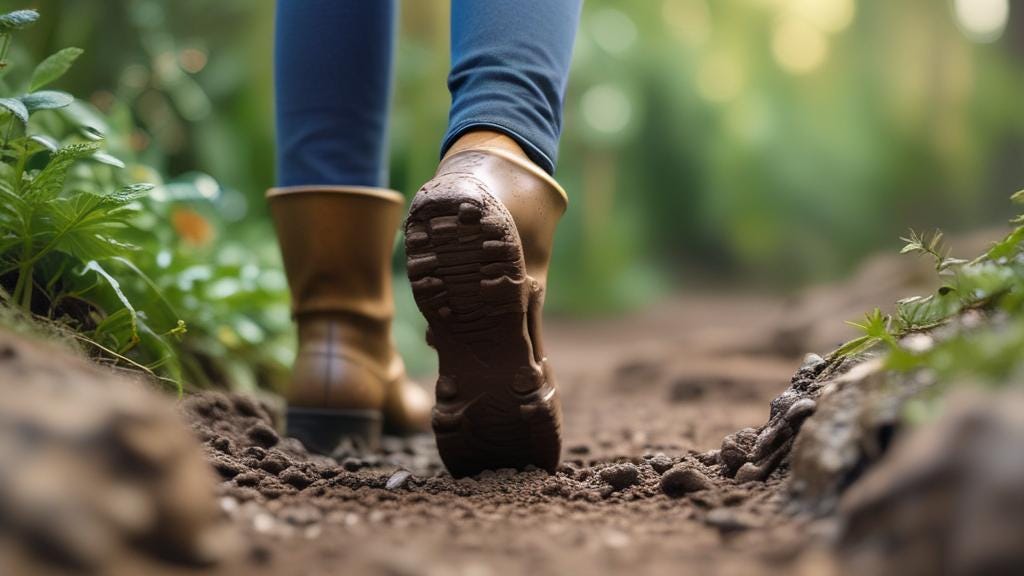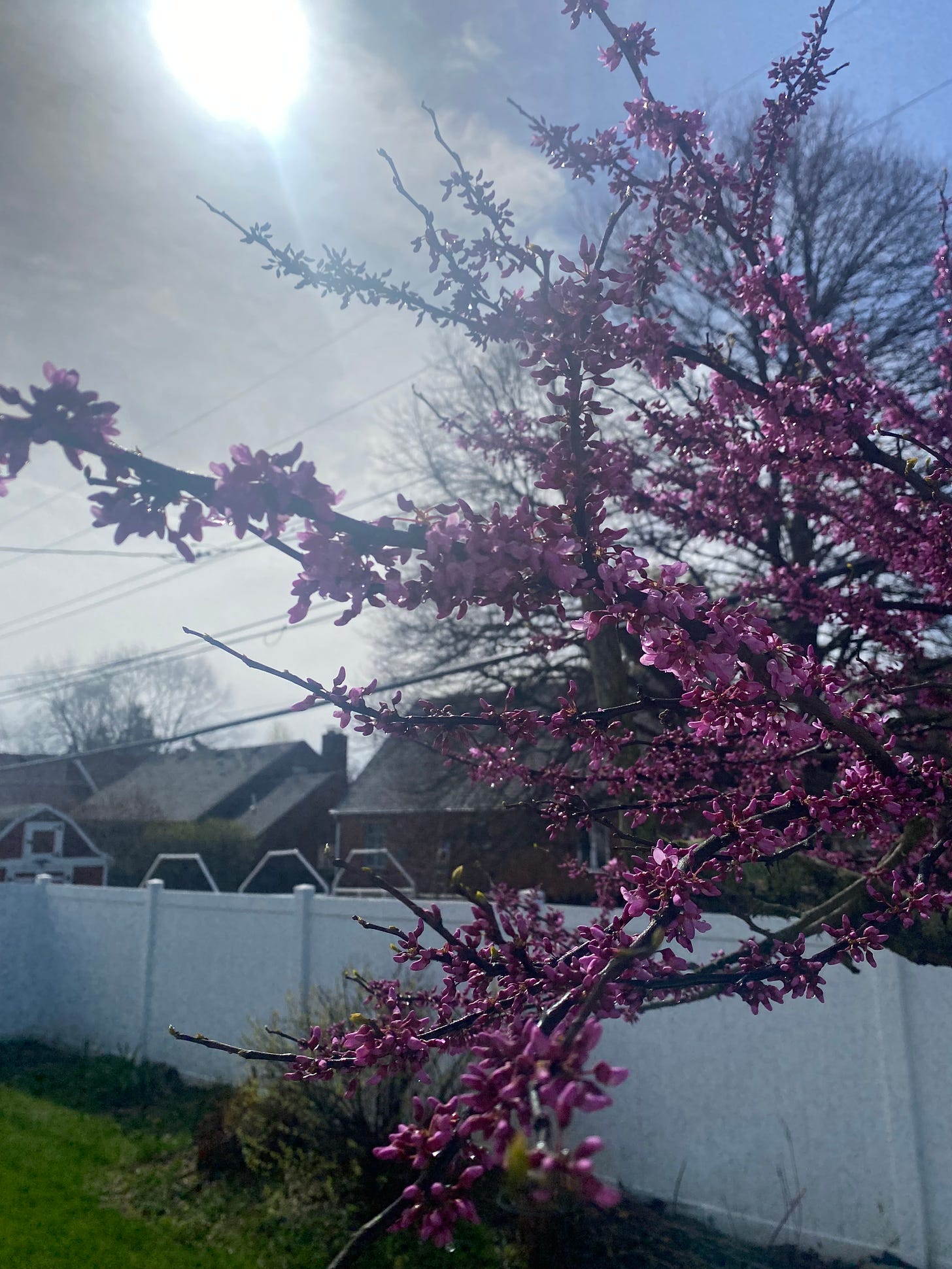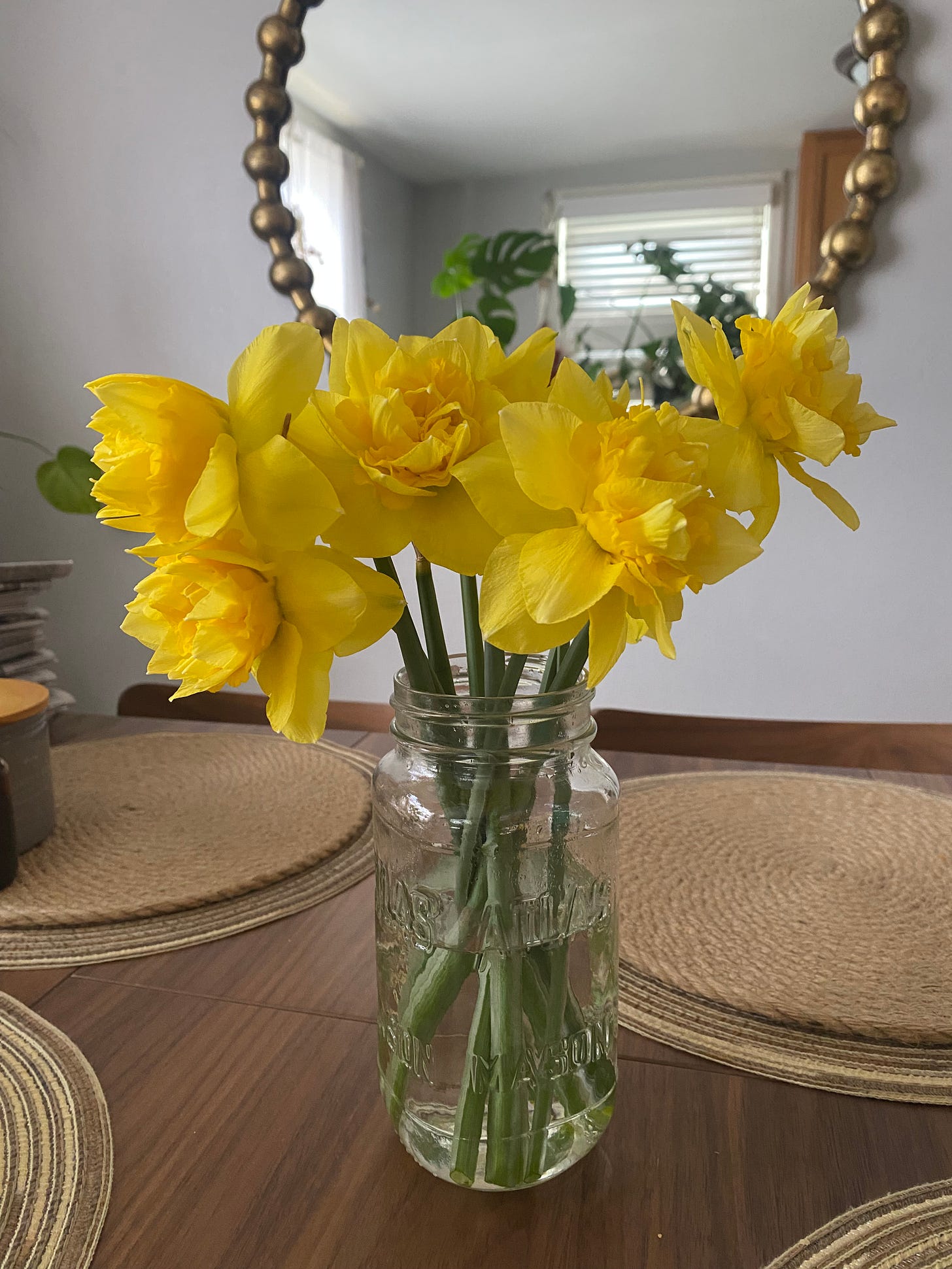Love note to a waking-up world
Mud, lilacs, puddle-stomping, a mind-body disconnect, walks, staying open, the promise of spring, the joy of planting things
A quick housekeeping note: I’m trying something new with my Substack — I’ve recorded myself reading this essay out loud. To listen, just click the “Article Voiceover” player above.
The ground is soft, pliable beneath my feet. It is a sign that everything around me is shifting, moving. Giving up the permanence of winter.
But it’s muddy, too, and it’s easy to get stuck in the muck as we emerge from what feels like the most silent of seasons, even with the cacophony of sounds — birds chirping, music floating out of car windows, the buzz of bees around the early pollinator plants.
There is a memory I always associate with spring. My brother and I would run out into our driveway in our swimsuits, stomping barefoot through the puddles, legs streaked with dirt. We’d rush to the row of lilac trees bordering the road, and took turns standing beneath the clusters of flowers: one would shake the branches so the water would fly off, the other would stand beneath the blossoms, drenched and giggling. That memory is a love note to how we engage with our waking-up world, a way to be messy within the messiness, and the joy that comes when we just allow ourselves to be.
I am trying to get better at this: the being. The present moment. The shape shifting going on beneath my feet, literally and metaphorically.
Winter, for me, felt like a time of hardening. As someone who struggles mightily with seasonal depression, my natural defense mechanisms are to shut down and shut out, to close myself off from others and the world around me. It makes the world seem more bleak, like it has lost its wonder. Worse, this sort of closing-off puts a damper on my curiosity (at least, it did this year). And who am I without my curiosity?
I’ve been thinking more about how we tell stories. How sometimes, those stories can harden, can calcify — can become obstructionist by their very nature, blocking us off from a new possibility, a different way of thinking.
I know that brain makes sense of things by assigning story to it. Our brain looks for common patterns, common shapes. As the brain gets older and learns more things, it gets better at pattern recognition, and it creates shortcuts to get us from Point A to Point B of realization quicker. Which is great for efficiency, but not always great for our real-life curiosity or creativity — because sometimes, our brain’s best guess at the pattern is just plain wrong, yet we’ve already written off the other possibilities.
To be creative — truly creative — we have to be open. We have to suspend our own judgment, our assumptions, and the myriad other things our brains do to reinforce our own beliefs, to keep us comfortable, or to remain committed to telling ourselves a singular story. I think most of you know by now that there’s no singular shared story, other than the pure messiness of human experience that varies wildly from human to human.
Only by opening up — becoming more porous to the world and its many lessons, and to all people, the many teachers, will we be able to go beyond our default settings of belief and prejudice and access something more beautiful, more authentic, more transformative.
I write this unironically, as one who believes that narrative and story is critical for one’s survival and navigation of the world, and one who is constantly questioning her own narrative veracity. I am standing on shifting ground. I am trying to remain open to ambiguity.
Sometime last year, I took a Birkman Method Assessment for work (basically, a job-focused personality test). Results are broken into four quadrants: Doing, Communicating, Analyzing, and Thinking. I scored as “Thinking” in all 4 of the categories: Interests, Usual Behavior, Needs, and Stress Behavior. The fine points don’t matter so much for the purposes of this essay, but needless to say, I am a very “think-y” person.
The other day I was walking in the neighborhood, listening to a podcast1 from Cody Cook-Parrott (
), and they said something that resonated with me: that sometimes, all the action is happening above the shoulders, and there’s not enough connection with the rest of the body. (I’m paraphrasing here.) This made total sense to me, and also touched on the weird disconnect I experience during my own season of seasonal depression.So I thought about it some more. Even as a person who exercises and moves regularly, I’m a very think-y person whose head sometimes feels like it’s hovering above my body, loosely tethered by a string. One reason I do exercise, actually, is to reinforce the mind-body connection, the reminder that my whole body is deserving of my attention and appreciation, and to pull me out of the clouds and back to real life.
I’ve been taking neighborhood walks for several days now, and find myself excited to return to some of the highlights I noticed when I first started up again this spring: the delicate, miniature daffodils, not even five inches tall, with delicate teacup-on-saucer blooms, nodding their heads in the breeze. The sight of them gave me immense joy.
Which reminds me of this: that once upon a time, I wasn’t interested in growing flowers. I thought that it was frivolous, that they were unnecessary (which is obviously not true, because hello, pollinators). I wasn’t going to grow them because I couldn’t eat them. Sure, they are beautiful, I reasoned with myself. But what of that? It was almost like I didn’t believe in beauty for beauty’s sake. Joy for the sake of joy.
I can trace a moment back to A.’s apartment, in the days after his death. My parents and I were cleaning things out, trying to salvage important things. And there, in the corner — tulips arranged in a vase, their browning petals dropped around the base. A smattering of pollen across the tabletop. That image stuck with me: a signifier of beauty, despite the chaos around it. That urge for beauty in one’s life, despite pain and suffering. I thought — that was an attempt at joy. An attempt to bring beauty into a place of pain. If A. thought that way, why shouldn’t I?
One year, on the anniversary of A.’s death, I forced myself out of the house and to the hardware store, where I bought fresh flowers. I planted geraniums and columbine in the backyard. I texted my father, told him what I was doing. “I’m planting pine trees,” he texted back, and sent a picture. I didn’t ask, but deep down, I knew. There was an unspoken connection there, a desire to memorialize in the ways that we’re drawn to, a tribute of the beauty and the trees that A. once loved.
I realize now that these pockets of joy and beauty make a life more bearable, make a life worth living. All those little beads of joy piling up, filling our buckets.
Years later, I keep planting flowers. In the fall, I plant bulbs and bareroots, bit by bit. There is a lesson here: the bulbs do not waste their energy. They don’t try to force the sprouting, the budding, the flowering before it is time. They wait for the right conditions.
Winter has brought its own challenges this year. My need for rest has competed with the restless stirring of wanting to create, and I feel like I’m emerging a little off-balance. Winter came with a particularly potent bout of depression, where I felt like a brick wall was standing between me and anything productive. At some point, I thought I might write about depression, and so I tried — only to circle the same two to three thoughts over and over, a pattern that wasn’t healthy for me to repeat.
And now, spring has woken something up. I’m moving faster, but in fits and starts. Just as I cannot force something before its time — I sit with these pebbles of an essay for weeks (sometimes months, sometimes years) before writing them. Right now, I’m soaking it in, listening to the birds and insects, all the while thinking to myself, not yet, not yet. An internal birdsong of my own, with trust in the process, a trust in the return to creation.
There is something about the shifting ground beneath me that fills me with a sense of possibility. Everything in due time. It’s so close I can taste it.
Common Shapes podcast from Cody Cook-Parrott: “Six Tools for When You Don’t Know What To Do Next.”







Incredibly lovely, as usual, Ashley. I especially love your thoughts about being "think-y" -- I, too, am almost unbearably thinky; I, too, exercise to feel more present in my body; I, too, don't have it figured out -- how to pull on the tether of my brain and bring it down to where the rest of me is. It's always comforting to me, though, to read that others have the same experience and today, on the anniversary of a death of my loved one, all the rest of it, too -- thank you.